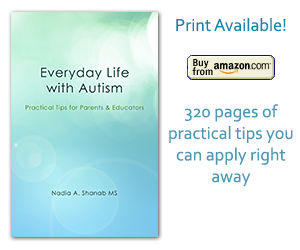Nadia Shanab | Uncategorized
“A research published in JAMA Psychiatry states that older men who have children are more likely to have grandchildren with autism compared to men who have children at a younger age.” The risk factor of autism accumulates over generations. It might skip a generation. We always thought that the parents’ age may be a factor
[read more]
Comments Off on Grandparents’ Age ls Linked to Autism Risk
Nadia Shanab | Uncategorized
NAO is the name of the humanoid robot, an elaborate and very sophisticated system, created to help children with ASD. The main function of NAO is to improve the social skills and communication abilities of children with ASD. Kids with ASD usually have poor joint attention. Joint attention, is the ability to synchronize the attention
[read more]
20 Mar 2013 | Tags:
autism,
communication,
health,
occupational therapy,
parenting,
research,
senses,
sensory,
social interaction,
speech,
visual aids Comments Off on A Humanoid to Improve Social Skills in Kids with ASD
Nadia Shanab | Uncategorized
Researchers believe that the increase of awareness might be behind the climb of this number. The ratio of boys to girls affected with autism is still the 4:1. The CDC (Centers for Disease Control and Prevention) and the U.S. Department of Health and Human Services believe that the increase might be due to the diagnosis
[read more]
Comments Off on Autism Prevalence Shot to One in 50 in The U.S.
Nadia Shanab | Uncategorized
Neuroscientists in Georgetown University Medical Center (GUMC) discovered a brain odditiy in individuals with autism that explains the deficit in identifying faces . This deficit in turn explains the behavioral disorder in social interactions, which is one of the most common traits of autism. They suggest that the level of behavioral deficit may be linked to
[read more]
Comments Off on Impairment in Social Interaction Is Linked to Deficit in Face Recognition
Nadia Shanab | Uncategorized
Transcranial Magnetic Stimulation (TMS) of the area of the brain containing mirror neurons may open a window on other people’s feelings. John Elder Robison admits that TMS had changed his life. Even when its effect wears off, the knowlege and awareness of the existence of how one’s feels other poeple’s emotions doesn’t go away. Watch
[read more]
Comments Off on Magnetic Stimulation of The Brain to Feel People’s Emotions
Nadia Shanab | Uncategorized
A new research study found that children with autism can be trained to aquire the social cognitive skills that would help them detect when people are lying to them. Spectrum children can also be trained to respond to bullies and protect their posessions. Parents’ concerns formed an important input for researcher to complete this study.
[read more]
17 Mar 2013 | Tags:
ABA (Applied Behavior Analysis),
asperger's syndrome,
autism,
communication,
discipline,
independence,
legal rights,
parenting,
social cognitive skills,
social interaction,
techniques,
tips Comments Off on Kids with Autism Can Learn to Detect Lies and Respond to Bullies
Nadia Shanab | Uncategorized
A study titled: “Developmental Meta-Analysis of the Funcitonal Neural Correlates of Autism Spectrum Disorders,” found that the brain activity changes as individuals with autism age. They found that the change in brain activities keeps developing over time. This is the first study to show that. “If the shift in the parts of the brain that
[read more]
Comments Off on Brain Activities Change As Individuals with Autism Age
Nadia Shanab | Uncategorized
“Signs of autism can be detected in the brains of 4-months old infants.” Researchers used near-infrared spectroscopy (NIRS) to study the brain activity of two groups of infants, one of which had a sibiling with autism. The babies were tested during a socially interesting human actions, (peek-a-boo), as well as while listening to some vocal
[read more]
Comments Off on Scanner ‘Shows Early Autism Signs’
Nadia Shanab | Uncategorized
Speech and language Pathologists (SLP) found that half of the children have echolalia as part of their language development progress. The difference between NT (Neuro Typical) kids with and without echolalia (NOT including ASD kids) is that their self-generated language develops later, but eventually they still can catch up. Spectrum kids, on the other hand,
[read more]
Comments Off on Echolalia Signals A Delay Not A disorder
Nadia Shanab | Uncategorized
It is much easier to deal with sensory issues in younger children with ASD wether at home or in classrooms. Wearing headphones and typical weighted vest is much less tolerated in junior high or high school. How can you help your teenager with ASD? Tips 1- To relieve stress, replace the figity objects with stress
[read more]
Comments Off on Tips to Help Teens with Sensory Issues

